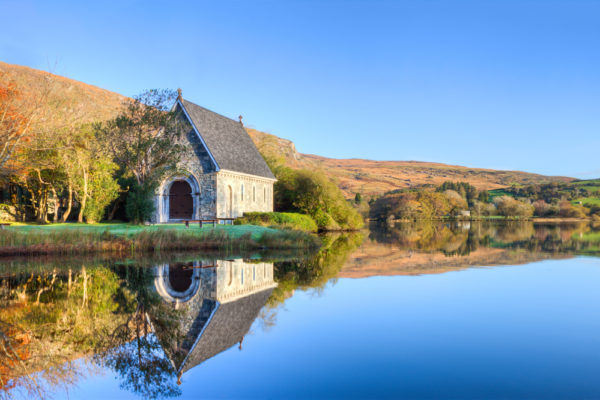Disclosure: As an Amazon Associate and an Affiliate of other programmes, I earn from qualifying purchases. This page may contain affiliate links, which means I may receive a commission if you click a link and purchase something that I have recommended. There is never an additional cost to you.
Table of Contents
Welcome to our post “10 Must See Places To Visit In Northern Ireland”
No visit to Ireland is complete without a trip to Northern Ireland. Yes, it has a troubled past, but since the peace agreement of 1998, there has been a surge of interest in tourism. Nearly all tourist attractions were free from trouble anyway, but obviously, people were still wary of visiting Belfast & Londonderry/Derry, scenes of many atrocities from all sides involved in the “Troubles”. Happily, those days are firmly behind this beautiful country and it’s a place you will never forget.
Remember though, that this country is different to Ireland, as it’s part of the UK and therefore still uses the English pound £ as opposed to Ireland that uses Euros.
To pick out a top 10 was nigh impossible. Where do you end?, such is the abundance of “Must see in N.Ireland attractions”. We settled on our view of the “10 Must See Places To Visit In N.Ireland”. We could have added at least another 30, but these are our Best 10. We may add more later on, why not? On with the show!
1. Dark Edges is a must see in N.Ireland
If it’s good enough for Game Of Thrones it’s good enough for our list!
Even Games of Thrones were enchanted, as they used N.ireland for the filming of that top rated TV programme. Here you can see the cast travelling along the ‘Kings Road’ in the programme.
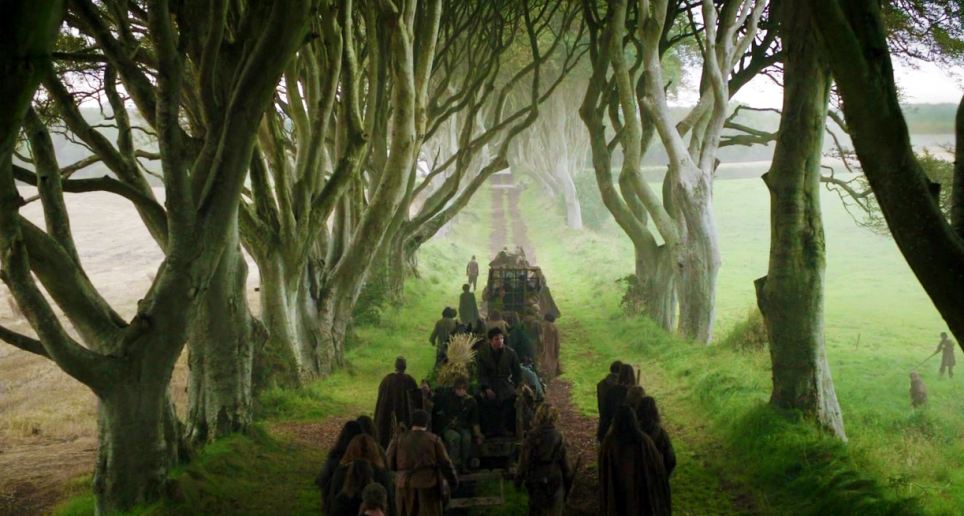
Season 2, Episode 1 – Arya Stark has escaped from King’s Landing, disguised as a boy. She is with Yoren, Gendry, Hot Pie and others who are to join the Night’s Watch, in a cart, travelling north on the King’s Road.
The beech tree-lined road is known as the Dark Hedges to locals near Stanocum in County Antrim, Northern Ireland. This beautiful avenue of beech trees was planted by the Stuart family in the eighteenth century.Two Centuries later, it has become one of the most photographed phenomena in the whole of Ireland.
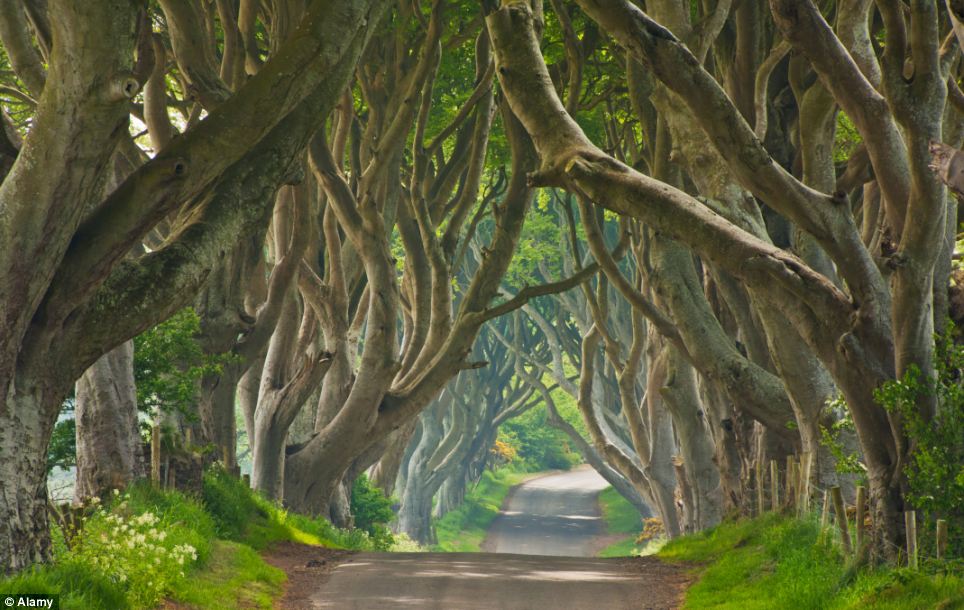
2. The Giant’s Causeway
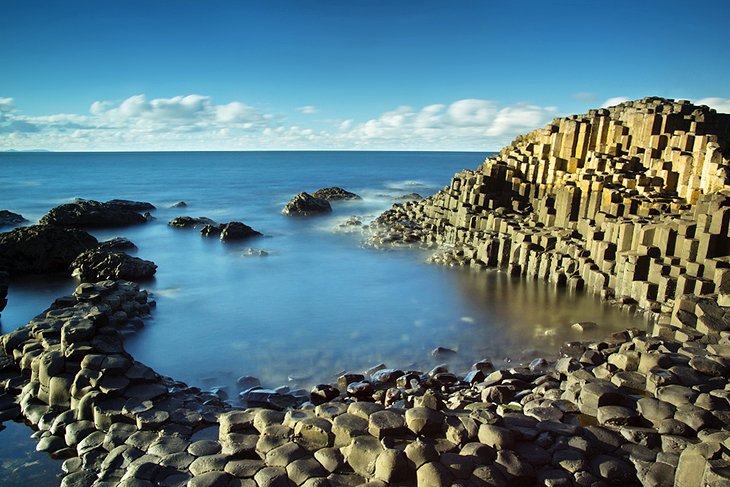
No visit to N.Ireland would be complete without a trip to this “Legend versus science” phenomenon.
Science tells us that during the Paleogene period (23-66 million tears ago) County Antrim was subject to intense volcanic activity. As lava rapidly cooled, unique contraction and fracturing occurred, creating the distinctive hexagonal columns seen today.
Legend tells us of an alternate tale of the Causeway’s creation!: The Irish giant Fionn MacCumhaill (Fionn McCool) built the causeway to walk to Scotland to fight his Scottish counterpart Benandonner. One version of the legend tells that Fionn fell asleep before he got to Scotland. When he did not arrive, the much larger Benandonner crossed the bridge looking for him. To protect Fionn, his wife Oonagh laid a blanket over him and pretended that the sleeping giant was actually their baby son. When Benandonner saw the size of the ‘infant’, he assumed the alleged father, Fionn, must be gigantic indeed. Benandonner fled home in terror, ripping up the Causeway in case he was followed by Fionn, and therefore only the Irish coastal steps remain.
I leave it up to you which one you believe. Me, well, let’s just say I love giants!
3. Dunlace Castle
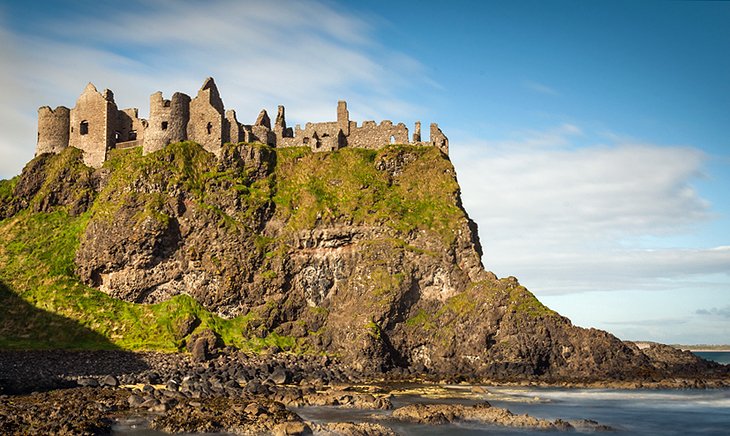
This Medieval Castle Ruins is impossible to miss, perched as it is, precipitously on the cliffs edge. It has a long and tumultuous history. First built on these dramatic cliffs off the north coast of County Antrim in the 15th Century, by the Mcquillan family. It was then seized by the MacDonnell clan in the 1550’s, who’s leader Sorely Boy MacDonnell set up a reign of violence, intrigue & rebellion.
In the 17th Century, Dunlace was in the hands of Irish Earls who set up a town nearby. Visitors can see the archaeological remains within the cobbled streets and stone merchant’s houses of the long abandoned Dunlace Town.
The Dramatic history of Dunlace Castle is only matched by its dramatic tales, including when one stormy night in 1639, the kitchen actually fell off the cliff into the Ocean below. Only one person survived, a kitchen boy who clung to the window sill, and was eventually rescued!
- Opening times- Daily 10-7 pm
- Prices- Adult – £5.50, Child (age 4 – 16) – £3.50, Senior citizen £3.50, Student and Benefit Claimants (ID required) – £3.50, Child under 4 – Free, Family (up to 5 members, including up to 3 adults) – £15.00, Group rate(10 plus, must be pre-booked) – £4 per person
- There is limited disabled access for wheelchair users.
- All children must be accompanied by an adult.
- No dogs allowed except guide dogs and assistance dogs.
4. Carrick-a-Rede Rope Bridge
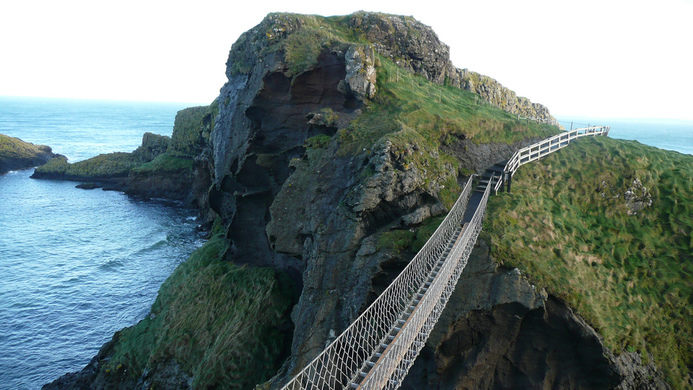
Nobody lives on Carrickarede island, but fisherman use it to catch Salmon and have done for hundreds of years. At first they built a crude bridge, but with Health & Safety a must when visitors arrive a new bridge was built to ensure the safety of Fisherman & visitors alike. But at 100 feet high, the 66 foot span is still vertigo inducing and not for the faint-hearted. The Salmon have long gone, but the attraction will continue forever me thinks.
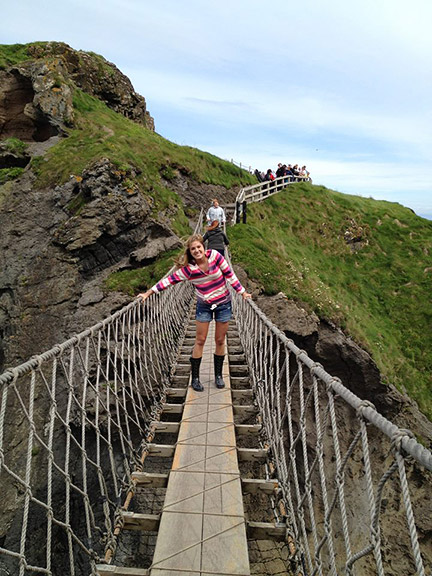
Once there was a basic bridge with wooden slats and one guide rope, but now there are steel wires and strong ropes, so it’s no loner the dangerous place it once was, but it’s still a scary 66 feet for all but the brave!. There are many stories of people who brave it across, but once there, are too afraid of going back, so have to be ferried off the island by boat!
5. Rathlin Island Sea Bird Colony
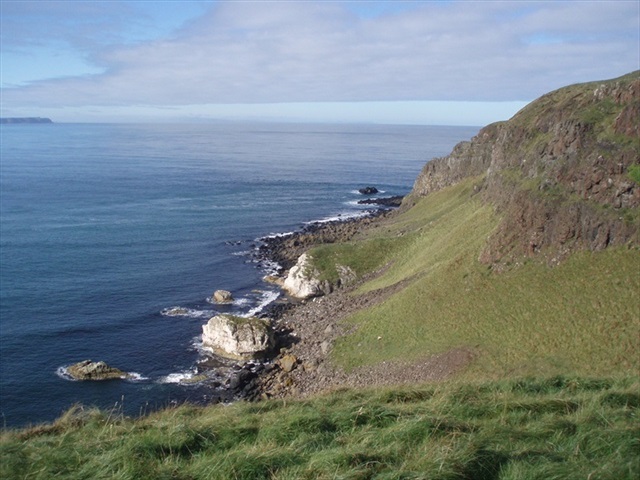
Rathlin Island is 6 Miles across the sea of Moyle. The Island is 6 Miles long by 1 Mile wide in a L shape. It’s calm and peaceful except for the noise of Seals and seabirds, as there are only about 140 human inhabitants on the whole Island!
Near the harbour is the Boathouse Visitor Centre, where visitors can learn historical facts, modern day Island life, shipwrecks and then a short walk to see the seals.
Many tales of myth and mystery surround Rathlin; perhaps the most famous tells of Robert the Bruce. In 1306, the Scottish King was driven from Scotland by Edward I of England and took refuge on Rathlin where he watched a spider persevering again and again to bridge a gap with its web. Eventually it succeeded. Taking heart from the spider’s efforts, he returned to Scotland and eventually regained his crown.
April to July is Puffin season and is a great time to see these lovely creatures along with other seabirds. The Seabird centre is open from Easter and there’s even a working lighthouse tour.
The island has a range of accommodation to suit different needs, a pub, restaurant, community shop and gift shop, offering Rathlin produced crafts. ‘Breakwater Studio’ features the work of local artist Yvonne Braithwaite.
6. Binevenagh Cliffs
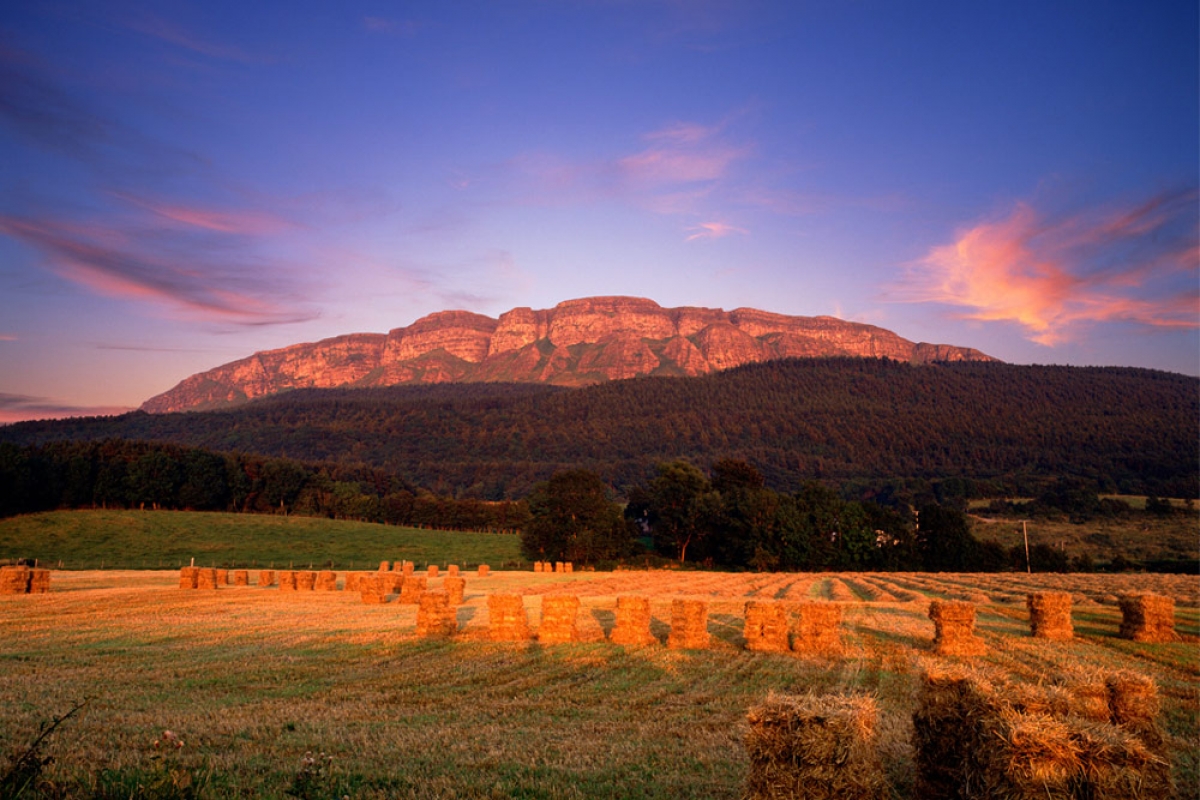
Binevenagh Mountain was formed over 60 Million years ago by molten lava. The steep cliffs spanning for 6 Miles and provide fantastic backdrop of panoramic views that have to be seen to be believed!
Situated at the western extent of the Antrim Plateau, the Mountain spans the peninsula of Magilligan and dominates the skyline over the villages of Bellarena, Downhill, Castlerock and Benone beach.
The surrounding cliffs and slopes are home to a large variety of rare alpine plants & birds. As such, the area is now designated as an area on outstanding natural beauty (AONB) and an area of special scientific interest.
7. The Glens Of Antrim
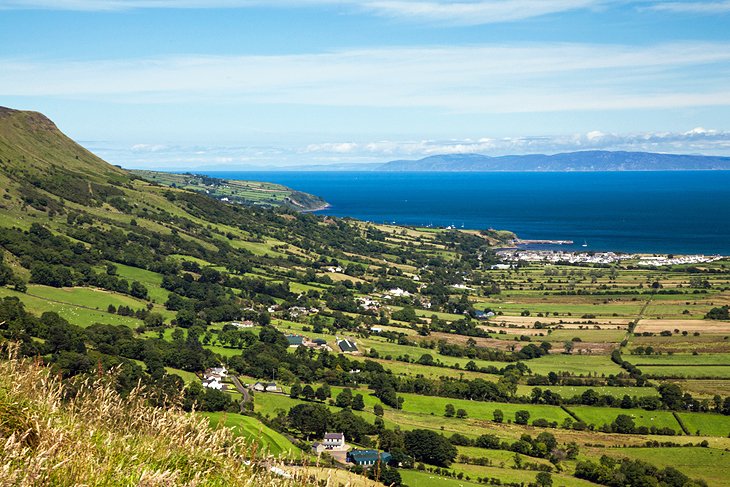
The Glens Of Antrim is another area of outstanding natural beauty (AONB). Drive from Ballycastle towards Larne along the main A2 coast road.
The 9 Glens will provide you a unique natural landscape that covers 20 sq Miles of beaches, Vertical Cliffs, Forests, Glens, Woods, Waterfalls & picturesque Villages. There are many ancient sites and places of interest are abound.
The small seaside resort town of Portrush, on the County Londonderry border, is home to the Royal Portrush Golf Club and one of the world’s most challenging links golf courses, the Dunluce Links
8. Carrickfergus Castle
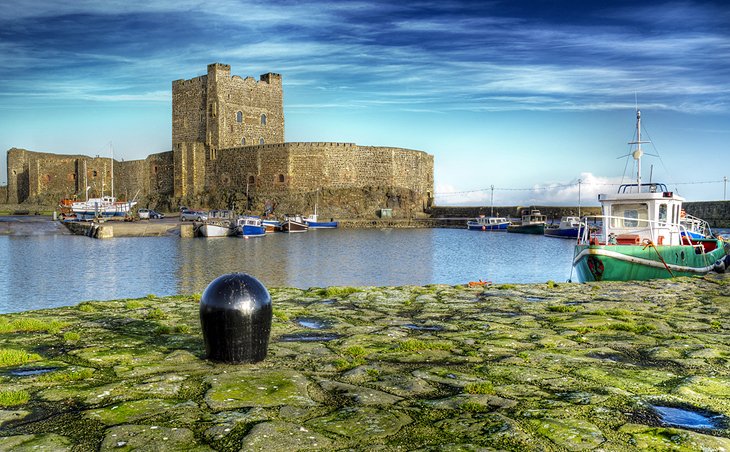
Only a 20 minute drive from Belfast, Carrickfergus Castle is situated in the town of Carrickfergus in County Antrim. It’s a Medieval Norman Castle that has certainly seen some historical moments, having been besieged in turn by the Scots, Irish, English and French army’s during it’s eight centuries. It was strategically important having once been surrounded by 3/4 of water.
Even so, it has survived and is now in the hands of N.Ireland Environment Agency, who have recreated the old banqueting Hall, which is a great visitor attraction, especially for kids! You can pick up a guide at the visitor centre and browse the interior & battlements at your leisure.
- Opening Times: Visitor Information Centre open daily from 09:00, Castle Grounds and Great Tower open: daily 10:00 – 17:00 (last entry 16:30)
- Prices: Adult – £5.50, Child (age 4 – 16) – £3.50, Senior Citizen – £3.50, Student and Benefit Claimants (ID required) – £3.50,Child under 4 – free, Family (up to 5 members, including up to three adults) – £15.00, Group rate (10 plus, must be pre-booked) – £4 per person
- There is limited disabled access for wheelchair users.
- All children must be accompanied by an adult.
- No dogs allowed except guide dogs and assistance dogs.
9. Belfast (Including the Titanic Belfast Centre)

No visit to N.Ireland would be complete without a visit to Belfast. We have done a whole article on Belfast as there is simply too many great Belfast attractions to name here. But even if you made the trip just for the Titanic Belfast Centre, it would still be worthwhile.
This centre cost £97 Million and tells the story of how the ship was built and launched in Belfast. The exhibition has nine interactive galleries – visitors can walk through the original Harland & Wolff shipyard gates, take a six-minute Shipyard Ride through different parts of the ship, with the sounds of riveting and smells of metal burning, and see replicas of the first-, second- and third-class cabins. There’s also a glass floor with video footage of the Titanic on the seabed.
Next door, the Titanic Slipways, where the ship and her sister ship Olympic were built, have been landscaped with lights, grass and decking to show the outlines of the actual ships. A few minutes away is Titanic’s Dock and Pump-House , where you can peer down into the 880 ft graving dock where Titanic sat for her final fit out. The best way to explore the Titanic Quarter is to take a tour – a two-hour walking tour includes access to the Dock and Pump-House and also to the Harland and Wolff drawing offices
- Address: Titanic Belfast, 1 Olympic Way, Queens Road,Titanic Quarter, Belfast BT3 9EP
- Phone: +44 28 9076 6386
- Website: http://titanicbelfast.com/
- Opening Hours: Jan-Mar 10am-5pm, Apr-May 9am-6pm, June-July 9am-7pm, Aug 9am-8pm, Sept 9am-6pm
- Prices: Adult £18.50, Child 5-16 £8, Child (under 5 ) Free, Student & Seniors (Over 60) £15, Essential Carer Free, Family pack 2 adults & 2 children £45
10. Londonderry (Sometimes just Derry)
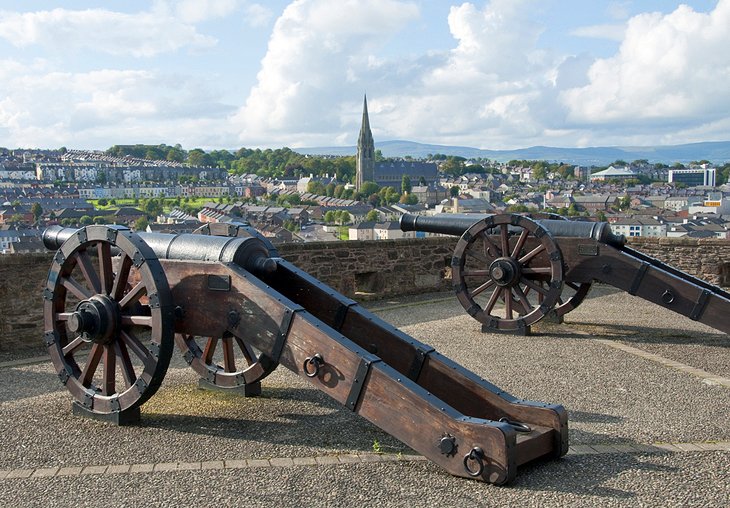
Again, no visit to N.Ireland would be complete without a visit to Londonderry (Derry). Has you can probably tell from my concern has to what to call it, it’s an ongoing problem with different factions calling it different names because of it’s troublesome past. In a nutshell, Irish Catholics call it Derry and Irish protestants insist it’s called Londonderry. Even the Lodonderry council are confused and sometimes refer to it as Londonderry/Derry which has come to be known as “stroke city” be the locals. All a bit confusing and a bit silly if you ask me. Many Cities and Towns are named by invading rulers and don’t get changed. Anyway, It’s a shame because it really is a great place to visit. Derry or Londonderry is the second-largest city in Northern Ireland and the fourth-largest city on the island of Ireland. The name Derry is an Anglicisation of the Irish name Daire or Doire meaning “oak grove”. In 1613, the city was granted a Royal Charter by King James I and the “London” prefix was added, changing the name of the city to Londonderry. While the city is more usually known as Derry, Londonderry is also used and remains the legal name.
The old walled city lies on the west bank of the River Foyle, which is spanned by two road bridges and one footbridge. The city now covers both banks (Cityside on the west and Waterside on the east). The city district also extends to rural areas to the southeast. The population of the city proper (the area defined by its 17th-century charter) was 83,652 in the 2012 Census, while the Derry Urban Area had a population of 105,066. The district is administered by Derry City Council and contains both Londonderry Port and City of Derry Airport.
The Greater Derry area, that area within about 20 miles (32 km) of the city, has a population of 237,000. This comprises the districts of Derry City and parts of Limavady district, Strabane district, and East Donegal (including Raphoe and St Johnston), along with Inishowen.
There are so many things to do in Londonderry/Derry that a new article just for this one City is being talked about with us.But here’s a taste of the things to do in Londonderry/Derry
- Walk the City Walls
- Tower Museum
- St Columbs Cathedral
- River Watch Aquarium
- Creggan Country Park
- St Augustine’s Church
- The City Gates
- Peace Bridge
- Siege Museum
- “The Troubles Tour”
- The Guildhall
Check out Derry’s own web site with lots of information as to attractions and accommodation here http://www.visitderry.com/
Thanks for visiting our Blog post. While your interested in Ireland why not take a look at another article “10 Best Places To Visit In North Republic Of Ireland”


